
A deer or true deer is a hoofed ruminant ungulate of the family Cervidae. It is divided into subfamilies Cervinae and Capreolinae. Male deer of almost all species, as well as female reindeer, grow and shed new antlers each year. These antlers are bony extensions of the skull and are often used for combat between males.

Musk is a class of aromatic substances commonly used as base notes in perfumery. They include glandular secretions from animals such as the musk deer, numerous plants emitting similar fragrances, and artificial substances with similar odors. Musk was a name originally given to a substance with a strong odor obtained from a gland of the musk deer. The substance has been used as a popular perfume fixative since ancient times and is one of the most expensive animal products in the world. The name originates from the Late Greek μόσχος 'moskhos', from Persian mushk and Sanskrit मुष्क muṣka derived from Proto-Indo-European noun múh₂s meaning "mouse". The deer gland was thought to resemble a scrotum. It is applied to various plants and animals of similar smell and has come to encompass a wide variety of aromatic substances with similar odors, despite their often differing chemical structures and molecular shapes.
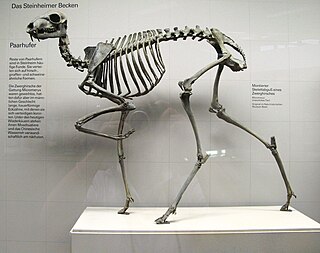
Moschidae is a family of pecoran even-toed ungulates, containing the musk deer (Moschus) and its extinct relatives. They are characterized by long 'saber teeth' instead of horns, antlers or ossicones, modest size and a lack of facial glands. While various Oligocene and Miocene pecorans were previously assigned to this family, recent studies find that most should be assigned to their own clades, although further research would need to confirm these traits. As a result, Micromeryx, Hispanomeryx, and Moschus are the only undisputed moschid members, making them known from at least 18 Ma. The group was abundant across Eurasia and North America during the Miocene, but afterwards declined to only the extant genus Moschus by the early Pleistocene.
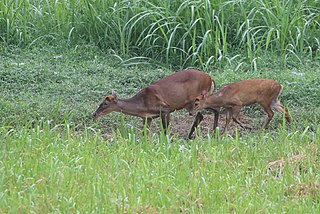
Muntjacs, also known as the barking deer or rib-faced deer, are small deer of the genus Muntiacus native to South Asia and Southeast Asia. Muntjacs are thought to have begun appearing 15–35 million years ago, with remains found in Miocene deposits in France, Germany and Poland. Most are listed as least-concern species or Data Deficient by the International Union for Conservation of Nature (IUCN), although others such as the black muntjac, Bornean yellow muntjac, and giant muntjac are vulnerable, near threatened, and Critically Endangered, respectively.

The southern red muntjac is a deer species native to Southeast Asia. It was formerly known as the Indian muntjac or the common muntjac before the species was taxonomically revised to represent only populations of Sunda and perhaps Malaysia. The other populations being attributed to this species are now attributed to Muntiacus vaginalis. Muntjacs are also referred to as barking deer. It is listed as Least Concern on the IUCN Red List.

The water deer is a small deer species native to Korea and China. Its prominent tusks, similar to those of musk deer, have led to both subspecies being colloquially named vampire deer in English-speaking areas to which they have been imported. It was first described to the Western world by Robert Swinhoe in 1870.
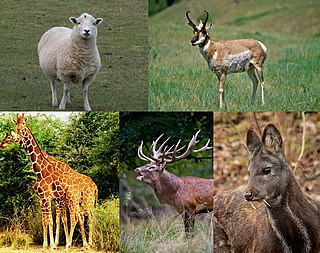
Pecora is an infraorder of even-toed hoofed mammals with ruminant digestion. Most members of Pecora have cranial appendages projecting from their frontal bones; only two extant genera lack them, Hydropotes and Moschus. The name "Pecora" comes from the Latin word pecus, which means "cattle". Although most pecorans have cranial appendages, only some of these are properly called "horns", and many scientists agree that these appendages did not arise from a common ancestor, but instead evolved independently on at least two occasions. Likewise, while Pecora as a group is supported by both molecular and morphological studies, morphological support for interrelationships between pecoran families is disputed.

The Siberian musk deer is a musk deer found in the mountain forests of Northeast Asia. It is most common in the taiga of southern Siberia, but is also found in parts of Mongolia, Inner Mongolia, Manchuria and the Korean peninsula.

The white-bellied musk deer or Himalayan musk deer is a musk deer species occurring in the Himalayas of Nepal, Bhutan, India, Pakistan and China. It is listed as endangered on the IUCN Red List because of overexploitation resulting in a probable serious population decline.

The yellow-throated marten is a marten species native to the Himalayas, Southeast and East Asia. Its coat is bright yellow-golden, and its head and back are distinctly darker, blending together black, white, golden-yellow and brown. It is the second-largest marten in the Old World, after the Nilgiri marten, with its tail making up more than half its body length.
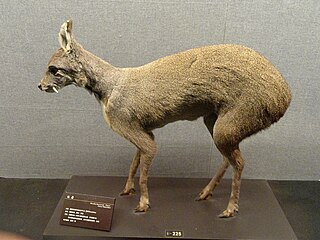
The dwarf musk deer or Chinese forest musk deer is an artiodactyl native to southern and central China and northernmost Vietnam. The species name is after the collector Mikhail Mikhailovich Berezovsky. On June 14, 1976, China entered the dwarf musk deer onto its endangered species list. Four subspecies are recognized:

The black musk deer or dusky musk deer is a species of even-toed ungulate in the family Moschidae. It is found in Bhutan, China, India, Myanmar, and Nepal.
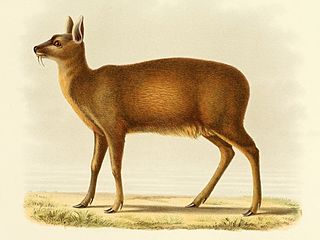
The Alpine musk deer is a musk deer species native to the eastern Himalayas in Nepal, Bhutan and India to the highlands of Tibet.

Micromeryx is an extinct genus of musk deer that lived during the Miocene epoch. Fossil remains were found in Europe and Asia. The earliest record (MN4) of the genus comes from the Sibnica 4 paleontological site near Rekovac in Serbia.
Kedarnath Wild Life Sanctuary, also called the Kedarnath Musk Deer Sanctuary, is a wildlife sanctuary declared under Wildlife Protection Act, 1972 and located in Uttarakhand, India. Its alternate name comes from its primary purpose of protecting the endangered Himalayan musk deer. Consisting of an area of 975 km2 (376 sq mi), it is the largest protected area in the western Himalayas.It is famous for alpine musk deer, Himalayan Thar, Himalayan Griffon, Himalayan Black bear, Snow Leopard and other flora park and fauna. It is internationally important for the diversity of its flora and fauna.

Deer musk is a substance with a persistent odor, obtained from the caudal glands of the male musk deer.

The Kashmir musk deer is an endangered species of musk deer native to Afghanistan, India, and Pakistan. It was originally described as a subspecies to the alpine musk deer, but is now classified as a separate species. It stands at 60 cm (24 in) tall, and only males have tusks which they use during mating season to compete for females.

The Anhui musk deer is an endangered species of musk deer that is endemic to the Dabie Mountains of western Anhui province, China. It was formerly described as a subspecies of Moschus berezovskii and Moschus moschiferus, but is now classified as a separate species.
Hispanomeryx is an extinct genus of artiodactyl from the middle to late Miocene epoch, living from 13 to 8 million years ago. Over the years, they have been variously classified as being related to bovids or giraffes, or even belonging to their own unique family, but they are now widely regarded as moschids, relatives of the living musk deer.




















